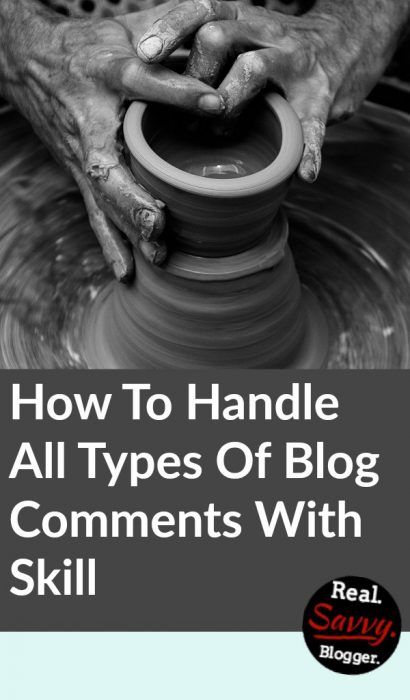How To Handle All Types Of Blog Comments With Skill
There is nothing better than getting a ton of comments on a post you’ve worked hard to produce.
You love to hear what others have to say about your writing and the topics that are near and dear to your heart. It makes you feel successful when readers share how much a post has helped them or they agree with your stance on a topic.
But what about the comments that aren’t so nice? What about readers who disagree with you or don’t like your opinions or even you it seems?
How do you handle these types of blog comments with skill?
How do you deal with them in a way that is classy, even when they hurt?
We live in a very public world. I think it’s safe to say that all this publicity has led many people to believe they can say whatever they want, whenever they want to say it. Often times it’s not very nice.
Not everyone has what it takes to respectfully disagree with others online. We see it again and again.
This applies to your blog as well. Blog comments usually follow a pattern. The more readers you have the more likely you are to receive negative feedback from those who aren’t afraid to voice their opinions of you or your writing.

For small bloggers a harsh comment can really sting. When you aren’t getting that many comments anyways, an unkind word really stands out.
For big bloggers these numbers are much higher. More readers, more comments, more unkindness. Even though they may have hundreds of positive comments I’m pretty sure negativity hurts just the same.
So, how do you handle all types of blog comments?
Evaluate wisely
Not all comments should be left up for everyone to see. But not all hurtful or harsh comments should be removed either. I believe there is a balance.
If a comment is particularly rude, off topic, contains foul language, or attacks you, the writer, without merit, I think it should be removed. We want to promote respectful disagreement on our blogs and on social media.
However, if a comment does disagree with your stance or opinion and it is respectful in it’s wording, even if still hurtful, I believe you should leave it up.
What is important is that you evaluate the comment wisely. Is it rude for rudeness’ sake or is it just a different viewpoint? Differing points of view can benefit readers.
Serve your readership as a whole
If every comment you receive is positive then you are preaching to the choir. Admittedly this is fun, but not particularly useful in the long term. So, what about other types of blog comments?
Negative comments can serve your readers as much as your posts. They can lead you to clarify ambiguous language. They can help you to improve in your writing, communication, and delivery. They can help improve the overall experience of readers, which is why you write, to help others.
Negative comments can help teach readers that there are differing opinions. They can shine a spotlight on opposing viewpoints. And they might verbalize what others are afraid to say.
In business, they say every contact a company gets represents 100 people who have the same opinion but didn’t respond.The same might be said for your blog. That’s a lot of un-communicated feelings.
In particular watch for comments about blog design, font, and ease of use. If someone can’t read your posts because you are using a creative font, consider changing it to make it easier for others to read and enjoy your content.
While it might be sad to change a font you really like, if it improves the readability of your site and serves your readers better, you should do it. And leave the comment up so others can see the process of how someone expressed dissatisfaction, you changed, and the experience got better for everyone.
Being able to see this progression serves your readers as a whole. Everyone can learn from your experience. Don’t deprive others of a chance to improve themselves.
Don’t be afraid to apologize
If you make a mistake and someone calls you on it, do not hesitate to say you’re sorry. Blogging is not a place for pride to take root. Be gracious, apologize, and move on.
I once wrote something that someone else took great offense to. It was not my intention to offend. I thought I was being helpful and teaching my readers but my approach was wrong.
When I was called on it I immediately apologized and asked for forgiveness. In that particular case it was warranted. I was in the wrong.
I’m not saying you always have to say you’re sorry for your opinion or viewpoint. I’m only saying when you are wrong, own up to it and move forward.
Take as much time as you need to make your apology genuine. If you need to cool off for a day or so, do it. You want to run your blog with a clean slate, not with an attitude of dissent and conflict.
Don’t beat a dead horse
Once you either apologize or state your case for your viewpoint to a negative comment feel free to move on. I often see comment threads to on and on and on. I feel this is unnecessary, especially if it is your blog.
Accept the negative comment (after making a wise evaluation), respond, let it go.
I like to practice the sandwich approach to responding to negative comments. Start with a positive like “Thank you for taking the time to read my post and respond.”
Then state your opinion why you think the comment has merit or not. If you need to apologize, do so here. If you believe what you wrote is true or factual, say so. Be strong and stand up for yourself.
Finally, thank the person for visiting and leaving a comment. Show appreciation for their taking the time to write.
Positive statement/meat or viewpoint/Positive statement = sandwich.
Then move on.
Comments are vital to a healthy blog. Both positive and negative comments have value. Make sure you handle both with class. Don’t be afraid of negative comments and don’t be afraid to stand up for your opinions.
You can handle all types of comments with skill. It just takes practice.
How do you handle different types of blog comments?










Great tips. So far, in the six years I’ve been blogging, everyone has been very nice. Have a blessed week!
Thanks for stopping by Barbie. I’ve had pretty good comments myself. It’s nice to have nice readers, isn’t it? I hope your week is fantastic!
New to blogging Debi, comments are not in big numbers and but luckily, all the comments have been positive so far. I am anticipating some harsh ones as well along the journey thanks for a good reminder.
thanks for a good reminder.
PS I liked your home page re-design :)) Take Care
I get a lot of great comments too Ahmad. It’s wonderful to have such a kind and generous audience, but I know there are those who probably disagree with me too. Learning to be gracious is a good skill to master as a blogger. Thanks for stopping by. I appreciate your awesome support. I’m glad you like the new homepage. I’m liking your site too. it looks great!